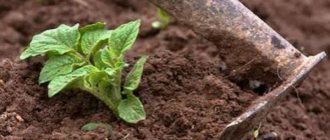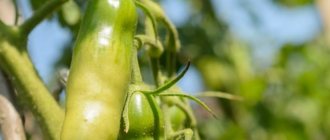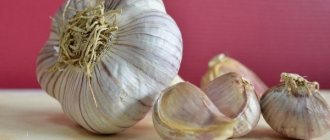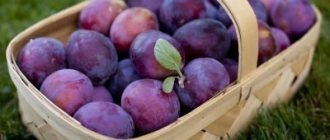» Vegetable growing » Tomatoes » Varietal characteristics of the Lakomka tomato
0
2858
Article rating
The determinate tomato Lakomka was bred by domestic breeders and gained great popularity among gardeners due to its early ripening and high yield. The first fruits ripen in early summer and have excellent taste and marketing qualities. Even a beginner can grow this variety.
- Advantages and disadvantages
- Features of cultivation
- Seed preparation
- Priming
- Planting container
- Sowing technology
- Crop care
- Transplanting into a greenhouse
- Transplanting to a garden bed
- Rules of care
- Common mistakes when growing
- Reviews from gardeners
Varietal characteristics of tomato Gourmand
Characteristics and description of the Lakomka tomato variety
Gourmand is classified as a determinate tomato. This is one of the fastest ripening varieties: no more than a month and a half passes from planting to the first red fruits. The height of an adult plant reaches half a meter. It does not have lush foliage; low bushes do not need to be tied up. Clusters with ripening fruits require special support if there are many of them and there is a risk of damage to the branch.
Despite its compactness, the Lakomka tomato is distinguished by its productivity: one bush can produce up to 7 kg of tomatoes. The plant is hardy, tolerates changes in weather conditions well, and is not afraid of drought and tomato diseases. Gourmand can be planted both in a greenhouse and in open ground.
Important! There are two varieties of Lakomka: red and black. The first variety is low-growing, rarely taller than 50 - 60 cm. And the Black Gourmet bushes are capable of reaching the height of human height.
Planting and caring for tomatoes in a greenhouse
To obtain an earlier harvest, many gardeners have equipped greenhouses on their plots. If you decide to grow Lakomka in greenhouse conditions, you should remember some nuances:
- A biofuel greenhouse will be most effective if it is installed in a place where it is slightly protected from sunlight. It is installed in an area that has been previously cleared of snow. The earth is dug up, and fresh manure mixed with sawdust is placed around the entire perimeter of the greenhouse.
- Seedlings can be planted in soil heated to 10 degrees.
- To plant Gourmet in a solar heated greenhouse, the soil is fertilized in the fall. The beds are dug up three weeks before planting seedlings, without turning out the podzol.
Advice! The yield of the early ripening Gourmand tomato in greenhouse conditions increases significantly if self-pollination is carried out daily. To do this, it is enough to lightly shake the plant bush three times a day.
Pros and cons of the Lakomka tomato variety
There are almost no negative aspects to Lakomka tomatoes. If the summer is not too sunny, the bushes need to be fed, otherwise the yield will decrease. Due to the lack of sun and heat, the first tomatoes may be a little late and ripen not after 80, but after 100 days.
Advantages of the variety:
- precocity;
- immunity to tomato diseases;
- resistance to temperature changes;
- drought tolerance;
- unpretentiousness;
- high productivity;
- good germination;
- the possibility of growing in a greenhouse, hotbed or open ground;
- pleasant taste;
- versatility of fruit use;
- excellent transportability.
Advantages and disadvantages
- The main advantages of the variety:
- high productivity;
- unpretentiousness;
- drought resistance;
- versatility of fruits;
- excellent taste of the crop;
- the fruits set well even in unfavorable weather conditions;
- increased immunity against characteristic infections of the culture.
- The disadvantages of Lakomka include the following features:
- fruit seeds are unsuitable for further growing plants;
- whole fruits are not suitable for canning;
- during heat treatment, the peel instantly loses its integrity;
- plantings require frequent fertilizing; without this, crop yields decrease sharply.
Optimal growing conditions
The variety develops and bears fruit equally well in a greenhouse, open ground or greenhouse. The low growth and average density of foliage allows up to a dozen bushes to be compactly placed on a square meter of soil. When planting, as well as in the absence of sunny days, tomatoes require abundant watering. When fruits appear, it is necessary to ensure that the upper leaves do not interfere with the sun's rays, otherwise ripening may slow down. The plant does not require special care conditions: this tomato variety is considered one of the most unpretentious.
Care methods
Strawberry Gourmand is considered a fairly unpretentious plant. But despite this, the berry will require additional attention. Thanks to high-quality care, the harvest will be even more tasty and of higher quality. The basis for additional care for the Gourmand strawberry variety will be the application of fertilizing at the right time. Strawberry variety Lakomka needs both organic and mineral fertilizers. You can balance the supply of additional nutrients using a number of complex fertilizers.
Organic fertilizers are those types of fertilizers that are produced naturally. That is, both chicken or cow manure and humus can be considered organic matter. In this case, the Gourmand strawberry responds well to the addition of bird droppings. However, it is worth remembering that chicken manure itself is concentrated. And it is recommended to apply it in small doses and not allowing it to get on the foliage and roots of the berry. Reviews from gardeners also positively characterize the reaction of the Lakomka variety to the addition of mullein, but you should also be careful with it. It is recommended to apply it mainly to the rows between the beds.
Do not forget about the need to mulch the beds. Thanks to mulch, you can reduce the formation of weeds and also insulate the beds. Which is especially important during the off-season. The best type of mulch is pine needles and sawdust. If finances allow, you can use agrofibre. It is especially useful in the off-season, when the berries need the warmth that it retains. Agrofibre should be placed on the territory of all beds after weeding and basic care activities.
As you can see, the Lakomka strawberry variety is quite suitable for cultivation by both beginners and more experienced gardeners. With minimal financial and labor costs, you can get a high-quality and tasty harvest of your favorite garden crop from childhood.
Growing
Even a beginner in gardening can grow Lakomka tomatoes. All a tomato needs is timely watering after planting and on dry days. Common nightshade diseases, such as rot and late blight, do not have time to attack Gourmet, as the fruits ripen very quickly.
Growing seedlings
Gourmand tomato seeds are sold already processed, so you only need to prepare the soil mixture for planting. It is best to calcine the soil for seedlings in the oven for at least 40 minutes. at a temperature of 160 oC. If the seeds are not purchased in a store, but collected yourself, you need to soak them in a weak solution of potassium permanganate. High-quality seedlings need sufficient light and warmth. If necessary, grown plants are pruned after the appearance of the 2nd or 3rd true leaf.
Landing rules
As soon as the soil has warmed up sufficiently and the air temperature does not drop below 15 ° C, you can plant tomatoes in a greenhouse or greenhouse. Plants do not grow in width and are not thickened with foliage, so the distance between them can be kept small, 25 - 30 cm: per 1 sq. m you can plant an average of seven Lakomka bushes.
It is best to prepare the holes in advance. Pour wood ash and a couple of handfuls of humus into each. Seedlings should be planted in the evening, since at night tomatoes better tolerate stress and adapt to new conditions.
Watering and fertilizing
The Gourmand tomato loves water, but a golden mean must be observed. Watering should be good, but not excessive, so that the tomatoes do not get sick: the frequency of water supply should be reduced as soon as the bushes begin to gain color. You need to water right to the roots. Water that gets on the leaves and stem during a hot day can burn the plant in a short time.
It is not necessary to feed tomatoes: fertilizers are applied mainly to increase yield. Young seedlings are given complex foliar feeding. It is better to feed the seedlings with a solution of fresh cow manure, in a ratio of 1:5 (1 kg of fertilizer per 5 liters of water). In the second half of the growing season, it is better to use natural minerals (ash, compost), potassium salt, superphosphates or ammonium nitrate, as well as organic matter based on humates.
Advice! It is important not to overfeed the plants: 2-3 times a month will be enough, and at the beginning of the growing season they are done more often.
Pinching and tying
Tomatoes of this variety are classified as determinate low-growing, which means that they do not require either garter or pinching. Side shoots form on plants, but develop so slowly that they do not cause any damage to the main bush. It is not a bush that needs to be tied up and supported, but a branch with fruits. On average, a half-meter-high tomato bush produces 5–7 kg of fruit. If you do not organize support in time, the branch, or even the stem itself, may break off.
Formation
The Gourmand tomato does not require special shaping, since it does not grow tall and does not have dense foliage. Therefore, it is considered an ideal variety for beginners.
Important! Experienced gardeners do not throw away weak seedlings, but plant two bushes in one hole. A week after planting, a piece is cut off from both trunks on one side and the sections are connected to each other, securely fixing them with electrical tape or a bandage. After another week, the weakest stem is cut off. The tomato develops well, feeding from two roots. The fertility and endurance of such a bush doubles.
Protection from diseases and pests
The variety does not require protection from common nightshade diseases, such as late blight or rot. Protection from pests is carried out in the same way as other tomatoes, by spraying them with special preparations.
Planting tomatoes in open ground
Gourmand feels best on the southern slope. It is desirable that green vegetables grow in this place in the previous season. Tomatoes or potatoes themselves are considered undesirable precursors.
Mulching the soil, especially in spring, is of great importance for the successful cultivation of Gourmand. To do this, just cover the soil between the seedlings with a transparent film. This mode will help maintain soil temperature and moisture in optimal condition.
Shoots are planted in heated soil. The holes are prepared and fertilized about a week before planting. Immediately before lowering the tomato into the hole, water the soil with a weak solution of potassium permanganate.
An early ripening variety will successfully take root and produce a bountiful harvest if you pour a little onion peel into the hole. A bed for early ripening tomatoes is usually formed in two rows, keeping a distance of 40-50 centimeters between plants.
Characteristics and description of the tomato variety Black Gourmet
The Black Gourmet tomato was included in the State Register of the Russian Federation not so long ago: in 2015. Presented the variety to the general agro public. Unlike other dark varieties, Black Gourmet even has dark flesh. Compared to other tomatoes, these tomatoes have more antioxidants and increased nutritional value. The bush grows up to 2 m in height and requires more care than its red-fruited counterpart.
Characteristics
Black tomatoes are often called dark-fruited tomatoes, as their color varies from purple to dark brown. This color is given to vegetables by the natural pigments anthocyanins, which are found in beets or eggplants. Thanks to anthocyanins, which have high antioxidant activity, vegetables are very healthy. Consumption of these varieties helps reduce the risk of cancer cell formation. In addition, medical reviews of unusual vegetables are very positive. Dark-fruited tomatoes contain substances that strengthen the immune system, improve vision and restore vascular tone.
Black tomatoes differ from ordinary red fruits in their more pronounced taste, as they contain an increased amount of sugar and organic acids. They are consumed fresh and added to salads. Like red vegetables, dark-skinned tomatoes can be sealed in a jar for the winter. In general, in terms of the method of cooking and eating, these exotic varieties of tomatoes are no different from red ones. But they will decorate any dish with their unusual appearance. There are a large number of videos on the Internet in which housewives talk about using unusual tomatoes in cooking, and gardeners share their opinions on growing the crop.
Reviews of Lakomka tomatoes
Elena Mikhailova, 39 years old, Krasnodar
I manage to grow three Gourmet crops per season. Our summer is already in April, I plant the first seedlings, and immediately sow the seeds for the second layer. I really like the variety: over the summer I have time to make preparations, make juice and ketchup, and delicious adjika. I recommend to all.
Ekaterina Polikarpova, 48 years old, Kaluga
I bought a cottage with a greenhouse and decided to plant tomatoes. I read reviews about the Lakomka tomato and looked at the photos. The variety is compact, medium-leaved. It seemed tempting to get a good harvest from a compact bush, but I couldn’t believe that such an idyll would turn out. And in vain: despite the fact that the bushes are not as lush and tall as those of our neighbors in the country, my tomatoes ripened much earlier than those of other summer residents. According to standard agricultural technology, I planned to plant my stepson. The time has come - I looked into my greenhouse: but there’s nothing to grow! I’ll plant again, I’m not afraid the second time.
Andrey Panov, 59 years old, Volgograd
I’ve been making tomatoes all my life, keeping up with new products. I planted a gourmet plant and several bushes for testing. And I liked it: no special care is needed, no stepchildren, no bush garter required. As soon as the branches began to fill up, I installed special supports - and it was done. The tomatoes are tasty, sweet, my wife praised them when they preserved them. I'll probably plant more next year. It is difficult to care for varieties, but Gourmand requires almost no attention.
Reviews from gardeners
According to reviews from those who planted Lakomka, this variety deserves to take its place in every garden.
Marina, 35 years old, Barnaul: “I’ve been planting Lakomka for 2 years now, I’m very pleased. The tomatoes are small, all approximately the same, they are convenient to put in jars. We decided to try growing it without a greenhouse - everything was fine, no diseases. We ate it fresh in salads and prepared juice for the children. Now I will plant them all the time.”
Ekaterina, 48 years old, Voronezh: “The forecast promised a rainy summer. I heard that Lakomka is an early ripening variety, I bought seeds in order to have time to grow something before the rains, and Lakomka did not disappoint. The first ones ripened already in mid-July, although a lot of them cracked due to the rains, but we are still happy - we ate them both fresh and canned.”
Vladimir, 56 years old, Orel: “I’ve recently been gardening; the only tomatoes I planted were Gourmand. I received the harvest even earlier than promised in the instructions. Looks like the photo on the packaging, tastes great.”
Diseases and pests, how to fight
The Gourmand variety has good immunity to many diseases, but is often affected by late blight. As a preventive measure it is worth:
- Sprinkle the ground between the rows with wood ash.
- Treat the bushes with garlic infusion (100 g of garlic per 10 liters of water).
- Treat the bushes with a solution of iodine and yogurt (10 liters of water, 20 drops of iodine, 1 liter of yogurt).
If signs of late blight have already appeared, it is necessary to remove diseased plants and treat the bushes with special preparations.
Among the pests, potatoes are attacked by the Colorado potato beetle and the golden nematode. Wood ash or special preparations like Aktara will help against the beetle.
Important! Bushes affected by the nematode are dug up and destroyed.
The Lakomka variety is ideal for those who want to enjoy tasty and satisfying potatoes 2-2.5 months after planting. All that is required from the gardener is to fertilize the soil and save the bushes from pests, and then a large harvest is guaranteed.











